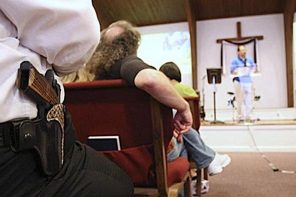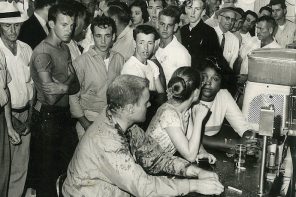Andrew Sullivan recently posted YouTube footage of LDS temple ceremonies in an effort to turn Romney’s Mormonism into an argument against his candidacy.
The video posted by Sullivan was shot surreptitiously inside LDS temples by a former Mormon who wanted to use the publicity connected with the Romney campaign to embarrass the LDS community. (The video creator enhanced the footage with his own monologue—wearing a gorilla mask—and spooky “Carmina Burana” soundtrack.) In late September, the video creator even claimed to have footage of Romney himself in temple ceremonies. That footage never materialized.
Throughout the fall election season, the former Mormon aggressively promoted his YouTube videos to media and religious outlets via email and Twitter, trying to get someone to run with the story. None did, until the footage made the Atheism subreddit page. And then Sullivan picked it up. It has now been viewed more than 1,000,000 times.
Many Mormons experience this YouTube temple ceremony expose as deeply disrespectful. Temple ceremonies are held sacred by LDS people and are generally not discussed in casual or public settings. The internet, however, has complicated the ability of LDS people to maintain those boundaries of privacy.
Andrew Sullivan is not the first media venue to depict LDS temple rites in a way that transgresses Mormon community ethics and norms.
Years ago, the HBO series Big Love dramatized the LDS temple ceremony, much to the chagrin of LDS Church members. It’s worth noting, though, that Big Love portrayed the LDS ceremony in a way that captured Barb’s participation in temple worship as a profound expression of spiritual longing as well as sense of the gentleness, otherworldliness, and beauty of the ceremony itself. Big Love even included the lightest touch of humanizing humor.
By contrast, in his depiction of LDS temple worship, Andrew Sullivan situates expose-style footage within prose that sensationalizes (and sometimes misstates) Mormon beliefs as repugnantly different. Sullivan says his goal is “transparency,” but his presentation is designed to make Romney (and Mormons) look menacingly alien.
Mormons customarily choose to respond to articles like Sullivan’s by not responding publicly at all. But if private LDS rituals are going to be trafficked in public, they deserve to be contextualized in basic information; not hyperpartisan and quasi-paranoid rhetoric. This post offers basic context and information about the LDS temple ceremony, but out of respect it does not link to footage of temple ceremonies or discuss specific details, and it uses only widely available descriptions of temple worship by a respected Mormon historian.
What are you seeing when you see those videos of LDS temple ceremonies? Simply put, LDS temple worship is a high religious ritual that includes standard elements of ritual used in other faith traditions, including ritual dress, symbol, gesture, morality play, and sacred boundaries. What makes the LDS temple ceremony seem so unfamiliar is that high religious ritual held private or secret has disappeared from most modern faith traditions—exceptions here being Native American traditions (especially Puebloan kiva ceremonies, also held in privacy) and the Ismaili sect of Islam (with millions of members worldwide). When high religious ritual does remain in modern Christianity and Judaism, ritual dress, symbol, gesture, and so forth are generally restricted to priests and rabbis. The difference in Mormonism is that there is no dedicated priestly class. All observant adult members are eligible to participate and wear the equivalent of priestly vestments.
The earliest forms of the LDS endowment were introduced in the 1830s by Joseph Smith. Matthew Bowman, author of The Mormon People: The Making of An American Faith (Random House, 2012), describes the endowment ceremony as instituted in 1842:
The men were washed and anointed, then dressed in a white garment and a robe in imitation of the priests of the Hebrew Bible. Then the initiates watched a ritual drama depicting the creation and the fall of Adam and Even from Eden, ending with the institution of priesthood authority as a means to regain that perfect state of divine communion. Along the way Adam and Eve—and the initiates, told to view this first couple as a model of themselves—made covenants to follow God’s commandments. Finally, they were ushered through the veil into the symbolic presence of God…
While in the temple, Mormons wear white clothes and the robes Joseph Smith introduced. They are also given the white garment upon beginning the endowment session, and are instructed to wear it beneath their clothes for the rest of their lives… Intended to be reminiscent of the skins in which God clothed Adam and Eve after the expulsion from the Garden of Eden in the third chapter of Genesis, the garment, Mormons are told, is a constant reminder of their dependence on God and the covenants they make in the temple to obey him.
Bowman notes that Joseph Smith developed the temple ritual six weeks after he and several other dozen Mormons were inducted into Freemasonry.
Joseph’s ritual mirrored Masonry partly in form… and in its construction of an initiation rite through elaboration of Biblical story and drama. Most of all the endowment used ritual to bind people together through oath and covenant. Freemasonry offered the same sense of an ordered world that Joseph was seeking to find in his faith; it is little surprise that he would find in the Masonic ritual the same inspiration that he found in Biblical texts. But unlike Freemasonry’s drama, which focused on the shadowy Biblical figure Hiram Abiff and hence was restricted to men, the endowment, focused on the pair of Adam and Eve, was open to women.
There have been changes to the temple ceremony over the years. For example, the ceremony once included an oath to “avenge the blood” of LDS Church founder Joseph Smith and his brother Hyrum Smith, who were assassinated while jailed in Illinois in 1844. Brigham Young developed and introduced the oath in 1845. It was removed in the 1930s.
When a former LDS Church leader named Reed Smoot was elected to serve as Utah Senator in 1903, ministerial associations across the country petitioned Congress that he was unfit to serve due in part to Smoot’s own participation in temple rituals, including this oath and a promise to dedicate himself and his resources to the LDS Church.
Just as did Smoot critics in 1903, during a period of high anti-Mormon suspicion in the US, the creator and the promoter of the YouTube temple video published by Andrew Sullivan claims that Romney’s own temple covenants would oblige him to put the interests of the Church above the interests of the nation were he to serve as president. Some bloggers who have recirculated the footage have echoed this claim.
Does making a temple covenant to religiously consecrate your life compromise your ability to serve in public office? In 1907, Reed Smoot was seated as Senator and served honorably for decades, as have dozens of elected LDS Senators and US Representatives since.
In reality, LDS people have a range of feelings about temple worship. Some have profound feelings about the temple as a space for meditation and reflection, while others are more reserved and even ambivalent about this dimension of the faith. And LDS people interpret and apply the promises of religious obedience they make in the temple in nuanced ways that allow them to balance religious obligation with the demands of everyday life in the secular world.
In this, Mitt Romney’s own example is instructive: his promises to consecrate his life to his religion have not prevented him from pursuing what is by all accounts an aggressively secular business career and accumulating his own fortune, even if he has earmarked a fraction of that fortune for donations to the Church. Nothing in his career as governor and nothing in his policy stances during this presidential campaign reflect any special influence of his Mormon faith.
I believe that Andrew Sullivan is right when he observes that whereas President Obama has been under intense scrutiny for elements of his religious and family life perceived to be unfamiliar by some Americans, Governor Romney has generally escaped comparable scrutiny of similarly unfamiliar elements of his religious and family life.
Yes, there has been a double standard. The name of that double-standard is racism. Disrespecting a religious community’s boundaries and hyping century-old suspicions of Mormons does nothing to combat the continuing force of racism in American life.



